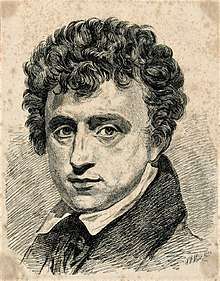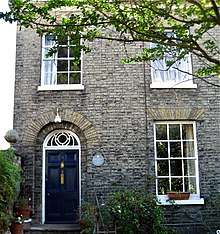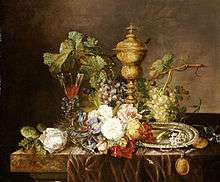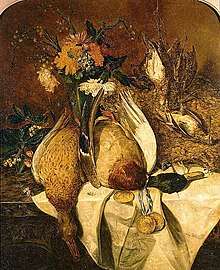Emily Stannard
Emily Stannard (née Emily Coppin; 8 February 1802 – 6 January 1885), also known as Mrs Joseph Stannard, was a British still life painter. She was associated with the Norwich School of painters, Britain's first provincial art movement. Along with her niece Eloise Harriet Stannard, she is considered to be the finest British female still life artist of the nineteenth century.
Emily Stannard | |
|---|---|
 Portrait of Mrs Joseph Stannard (1830–1885) by Julian Cedric Brewer (c. 1885)[1] | |
| Born | 8 February 1802 Norwich, England |
| Died | 6 January 1885 (aged 82) Norwich, England |
| Nationality | British |
| Known for | still life painting |
| Movement | Norwich School of painters |
| Spouse(s) | Joseph Stannard |
Emily Coppin was born in Norwich, the daughter of Daniel Coppin and his wife Elizabeth (née Clyatt), who were both accomplished amateur artists. In 1820, she travelled with her father to Holland to study the paintings of Jan van Huysum and other Dutch masters, an episode in her life which greatly influenced her work. She married the Norwich artist Joseph Stannard in 1826, but was widowed four years later, when he succumbed to tuberculosis. She continued painting until she was in her eighties, mainly depicting still life paintings of flowers in vases, fruit or game animals. Her works were exhibited in both Norwich and London. She was awarded a large gold medal in 1820 for an original painting of flowers and was awarded two further gold medals in later years. She became an honorary member of the Norwich Society of Artists in 1831, the only member of her artistic family to be formally associated with the Society.
The largest collection of her works are held by the Norfolk Museums Collections, based at Norwich Castle.
Life


Emily Coppin was born on 8 February 1802 in Norwich, the daughter of Daniel Coppin and his wife Elizabeth Clyatt. She was baptised at St Stephen's Church, Norwich on 14 February.[2] Both her parents were accomplished amateur artists.[3] Daniel Coppin, who was also a collector, was one of the founding members of the Norwich Society of Artists. Her mother was a talented copyist, but Emily far exceeded her artistic ability.[4] According to parish records her elder siblings were Frederic Daniel, Henry and Mary Elizabeth, and her younger siblings were Lucy and Edward (all christened between 1796 and 1805). Both of Emily's sisters died in infancy.[5]
Almost nothing is known of Emily Coppin's childhood or education. In 1820, she travelled with her father to Holland to study Dutch painting, which greatly influenced her subsequent work.[6][7] During her visit, she obtained permission to copy paintings by the Dutch Master Jan van Huysum at Trippon House, Amsterdam, and her work was praised for its accuracy. There, according to her obituary, "she complied with the conditions laid down by showing two specimens of her painting, the President of the Amsterdam Gallery, Mons. Apostal, expressing great satisfaction with her work, and she was allowed to make a copy of another Van Huysum".[8][9]
On 3 January 1826, when already an established artist who had exhibited works, she married the Norwich School painter Joseph Stannard in St George's Tombland, Norwich.[10] They were a well-matched couple, with both coming from artistic backgrounds.[4] Their daughter Emily was born in 1827.[6] A second daughter, Harriet Augusta, died in 1830 age 9 months.[11] The marriage was short-lived, for Joseph Stannard died of tuberculosis in 1830 at the age of thirty-three, despite the efforts of his wife, who tried many doctors and treatments in an attempt to save him.[12]
Stannard continued to live in Norwich for over fifty years, but only the notice she attracted in the press for her paintings gives any impression of her life during this period. According to census records for 1841–81 she was residing with her brother-in-law Alfred Stannard and his family on census night in 1841, but only with her daughter Emily from 1851 to 1881, when her occupation is described as 'Artist' or 'Artist Dead Life'.[13]
During her last years she lived at 12, Cathedral Street, Norwich, with her unmarried daughter Emily. She died there on 6 January 1885,[9] her will being proved by her daughter.[14] Her obituary appeared in the local press the week following her death, mentioning that "Mrs. Stannard had a great artistic merit, was a very clever painter of fruit, flowers, fish, game, and still life, and her pictures have always been highly esteemed by lovers of art", and describing "her kindly, gentle, modest, and simple nature (which) endeared her to all who had the pleasure of her acquaintance".[note 1]
Her gold medals were donated by her daughter to the new museum at Norwich Castle in 1894.[16][note 2]
Emily Stannard continued to live at Cathedral Street until her death in 1894 at the age of 67.[18]
Career
Background
The Norwich School of painters was a unique phenomenon in the history of British 19th century art.[19] Norwich was the first English city outside London where a school of artists arose.[20] It had more local-born artists than any subsequently-formed schools elsewhere,[21] its most important artists being John Crome, Emily Stannard's husband Joseph Stannard, George Vincent, Robert Ladbrooke, James Stark, John Thirtle and John Sell Cotman.[22] The Norwich School artists were connected by geographical location, their depiction of Norwich and rural Norfolk, and by close personal and professional relationships.[note 3] By the end of the 19th century the paintings by the artists of the Norwich School, who had once been regarded as modern and progressive, were seen as belonging to a bygone age, a view that Professor Andrew Hemingway has attributed to the "mythology of rural Englishness" that prevailed at the start of the 20th century.[24]
The Norwich Society of Artists was founded in 1803.[25] It held annual exhibitions from 1805 to 1825 and again from 1828 until its dissolution in 1833.[26] Members of the Stannard family showed their pictures at the exhibitions, but they had few other artistic connections with their Norwich contemporaries. Emily Stannard, who became an honorary member of the Society in 1831, was the only member of the Stannard family to have a formal association with the Society.[27]
Teaching
Emily, assisted by her daughter, had a career as an art teacher.[6] Hardly any information about this aspect of her life is provided by her past or present biographers.
Works


Emily Stannard and her niece Eloise Harriet Stannard are nowadays considered to be the finest British women still life painters of the nineteenth century.[12] Stannard's early paintings were influenced by the Dutch masters Huysum and De Heem.[28] Both her depiction of vases and the finish of her depiction of flowers owed much to Huysum, and her unsigned works were sometimes attributed to 18th century Dutch painters.[29] Still life: Dead Ducks and a Hare with a Basket and Sprig of Holly reveals her debt to Jan Weenix, whose work Dead Hare and Partidges she presumably saw when it was exhibited at the British Institution. Paintings by Dutch masters at country houses in Norfolk (such as at Wolterton Hall) may also have been available to her.[8]
She first exhibited her works in 1816.[30] In 1821, aged seventeen, she was awarded the Norwich Society of Artists' gold medal for one of her flower paintings.[4] She won a second medal the following year for a painting of a collection of fruit.[6] She received a third gold medal in 1828 for a still life of game animals,[31] which was exhibited at the Norwich Society of Artists as Dead Game from Nature.[30] Throughout her long career, which continued until shortly before her death at the age of 82, she continued to depict bouquets of flowers in vases and other traditional still life paintings of tableware, fruit or game animals, set against monochrome backgrounds.[32][33]
Although she usually exhibited her work in Norwich, she also exhibited paintings at the Royal Society of British Artists in 1824 and the British Institution from 1823 to 1825.[6]
According to the art historian and author Josephine Walpole, Emily Stannard's paintings display a "natural talent" and "impeccable colour sense".[3] According to Andrew Moore, her technique and command of composition strengthened in the years after her husband's death.[34]
On least one occasion she signed a painting using her Christian name,[29] but her works are invariably signed 'Mrs. Joseph Stannard'. Her canvasses, which were often left unvarnished, were consistently painted with a thin, diluted paint, in a similar way to the works of the Dutch masters she studied.[8]
The Norfolk Museums Collections is the only United Kingdom public art collection which possesses works by Emily Stannard. Her paintings there are: Still life: hamper with dead wood pigeon and leveret; Still life: dead ducks and a hare with a basket and a sprig of holly (1853); Still life with dead game and a flagon and a string of onions (1847); Dead game and a gun (1835); Dead game (1837); Flowers; Still life: group of dead game birds; and Wild duck (study).[35]
Prices paid for her paintings include £400 for Still life study of dead birds on a table oil on board in 2017, £1600 for Still Life Study of Mixed Flowers and Fruit in Basket on Marble Ledge in 2015, £920 for Still Life Study of Mixed Flowers, Birds Nest and Butterfly on Marble Ledge in 2015, and £130 for a watercolour painting Tranquil River Landscape in 2010.[36] Her larger painting The game larder (52 x 43.2 cm) was sold at Christie's in 2013 for £10,000.[37]
Notes
- Emily Stannard's full obituary in The Norfolk Chronicle read: "We regret to announce the somewhat sudden death of a charming old lady, Mrs. Joseph Stannard, of 12, Cathedral-street, in this city, on Tuesday, the 6th inst. Mrs Joseph Stannard, née Coppin, was one of the last remaining links of the old Norwich School of Artists. She was the widow of the well-known and excellent artist, Joseph Stannard, who died in 1830, at the early age of 34 years, in the prime of life, and while rapidly and steadily advancing in power and fame. Mrs. Stannard had a great artistic merit, was a very clever painter of fruit, flowers, fish, game, and still life, and her pictures have always been highly esteemed by lovers of art. In 1820 she received the large gold medal from the Society of Arts for an original painting of flowers. In August of the same year she went with her father to Holland, where in the Hague Gallery she made truthful copies of two precious small fruit pictures. At Trippon House, Amsterdam, she obtained permission to reproduce the celebrated Flower Pictures by Van Huysum. Her copies were greatly praised by celebrated foreign connoisseurs of the day for their close similitude of the originals. At Amsterdam she complied with the conditions laid down by showing two specimens of her painting, the President of the Amsterdam Gallery, Mons. Apostal, expressing great satisfaction with her work, and she was allowed to make a copy of another Van Huysum. In 1821 she was presented with the large gold medal of the Society of Arts, London, for an original painting of fruit. In 1828, as Mrs. Joseph Stannard, she received the gold medal for an original painting of game. As late as 1870 she exhibited in an exhibition at Norwich two very pictures of flowers and song birds, elaborately and beautifully painted, both of them brilliant and effective, which were very highly spoken of in the local journals at the time. Her kindly, gentle, modest, and simple nature endeared her to all who had the pleasure of her acquaintance, by whom she will ever be remembered with great esteem, regard, and affection. Many of the last years of her life were smoothed and cheered by the loving care and companionship of an only daughter, to whom we tender our sincere sympathy".[15]
- The museum described them as "Three Gold Medals inscribed the "Society of Arts and Commerce Promoted" awarded to Mrs. Joseph Stannard for painting, and the Silver "Honorary Pallet of the Society for Promoting Arts, Manufacturer and Commerce," awarded to Mrs. Coppin for Drawing".[17] Emily also donated the paintings of her parents and her grandmother Elizabeth Coppin, in what the author Kate Hill described as "an unusual example of an attempt to memorialise women artists".[16]
- The Stannards were the most conspicuous family of still-life painters in nineteenth century England. Alfred Stannard and his older brother Joseph specialised in painting landscapes and marine art, but with the encouragement of Emily Stannard included still-life works in their repertoire. Her niece Eloise Harriet Stannard in turn became a prominent painter flowers and fruit.[23]
References
- "Portrait of Emily Stannard". Norfolk Museums Collections. Retrieved 4 December 2018.
- Emily Coppin in "Archdeacons transcripts for Norwich parishes, 1600–1812", FamilySearch (Emily Coppin)
- Walpole 1997, p. 58.
- Moore 1985, p. 96.
- Search Results from Historical Records, FamilySearch ()
- Gray 2009, p. 249.
- Dickes 1905, p. 526.
- Moore 1988, p. 144.
- "Norfolk Chronicle and Norwich Gazette – Saturday 17 January 1885". The British Newspaper Archive. British Library. 2018. Retrieved 7 December 2018.
- Emily Coppin in "England, Norfolk Bishop's Transcripts, 1685–1941", FamilySearch (Emily Coppin).
- Harriet Augusta Stannard in "England Deaths and Burials, 1538–1991", FamilySearch (Harriet Augusta Stannard).
- Walpole 1997, pp. 58–59.
- Birth, Marriage, & Death, FamilySearch ().
- "Find a will". Government of the United Kingdom. Retrieved 7 December 2018.
- "The late Mrs. Joseph Stannard". The Norfolk Chronicle. Norwich: The British Newspaper Archive. 17 January 1885. Retrieved 5 April 2019.
- Hill 2016.
- Norwich Castle Museum Committee (1894), p. 15.
- "Eastern Evening News". British Newspaper Archive. 24 November 1894. Retrieved 14 December 2018.
- Moore 1985, p. 9.
- Cundall 1920, p. 1.
- Hemingway 1979, pp. 9, 79.
- Hemingway 1988, p. 17.
- Nunn 1995, p. 39.
- Hemingway 1988, p. 30.
- Rajnai & Stevens 1976, p. 13.
- Rajnai & Stevens 1976, p. 4.
- Moore 1985, p. 95.
- Moore 1985, p. 104.
- Mitchell 1973, pp. 242–4.
- Rajnai & Stevens 1976, p. 87.
- Mackie 1901, p. 354.
- Vincent 1992.
- Walpole 1997, pp. 58–9.
- Moore 1985, p. 105.
- Wright & Gordon 2006, p. 743.
- "Lot Results for: emily stannard". Keys Fine Art Auctioneers. Retrieved 4 December 2018.
- "Sale 1886 (Lot 483)". Christie's. Retrieved 4 December 2018.
Bibliography
- Cundall, Herbert Minton (1920). The Norwich School. London: Geoffrey Holme Ltd.CS1 maint: ref=harv (link)

- Dickes, William Frederick (1905). The Norwich school of painting: being a full account of the Norwich exhibitions, the lives of the painters, the lists of their respecitve exhibits and descriptions of the pictures. Norwich: Jarrold & Sons Ltd.CS1 maint: ref=harv (link)

- Gray, Sara (2009). The Dictionary of British Women Artists. Cambridge: Lutterworth Press.CS1 maint: ref=harv (link)
- Hemingway, Andrew (1979). The Norwich School of Painters 1803-1833. Oxford: Phaidon. ISBN 9780714820019.CS1 maint: ref=harv (link)
- Hemingway, Andrew (1988). "Cultural Philanthropy and the Invention of the Norwich School". Oxford Art Journal. 11 (2): 17–39.CS1 maint: ref=harv (link)
- Hill, Kate (2016). Women and Museums 1850-1914: Modernity and the Gendering of Knowledge. Cambridge: Manchester University Press. ISBN 978-0719081156.CS1 maint: ref=harv (link)
- Mackie, Charles (1901). Norfolk Annals: A Chronological Record of Remarkable Events in the Nineteenth Century Vol. 2 (1851–1900). Oxford: Norfolk Chronicle. ISBN 0-7148-2001-6.CS1 maint: ref=harv (link)
- Mitchell, Peter (1973). Great flower painters; four centuries of floral art. Woodstock, New York: The Overlook Press. ISBN 0-87951-008-0.CS1 maint: ref=harv (link)
- Moore, Andrew w. (1988). Dutch and Flemish Painting in Norfolk: A history of taste and influence, fashion and collecting. London: Her Majesty's Stationery Office. ISBN 0 11 701061 8.CS1 maint: ref=harv (link)
- Moore, Andrew W. (1985). The Norwich School of Artists. HMSO/Norwich Museums Service.CS1 maint: ref=harv (link)
- Nunn, Pamela Gerrish (1995). Problem Pictures: Women and Men in Victorian Painting. Scolar Press. ISBN 9781859281529.CS1 maint: ref=harv (link)
- Rajnai, Miklos; Stevens, Mary (1976). The Norwich Society of Artists, 1805-1833: a dictionary of contributors and their work. Norfolk Museums Service for the Paul Mellon Centre for Studies in British Art.CS1 maint: ref=harv (link)
- Vincent, Adrian (1992). A Companion to Victorian and Edwardian Artists. David & Charles. ISBN 1-85149-261-5.CS1 maint: ref=harv (link)
- Walpole, Josephine (1997). Art and Artists of the Norwich School. Woodbridge: Antique Collectors' Club. ISBN 1-85149-261-5.CS1 maint: ref=harv (link)
- Wright, Christopher; Gordon, Catherine (2006). British and Irish paintings in public collections : an index of British and Irish oil paintings by artists born before 1870 in public and institutional collections in the United Kingdom and Ireland. New Haven: Yale University Press. pp. 790–1. ISBN 9780300117301.CS1 maint: ref=harv (link)
- The Report of the Castle Museum Committee to the Town Council. Norwich: Edward Burgess. 1894.CS1 maint: ref=harv (link)
- Transactions of the Society, Instituted at London for the Encouragement of Arts, Manufactures and Commerce. 39 (2 ed.). London: Dodsley, Lockyer. 1821.CS1 maint: ref=harv (link)

External links
- 11 works by Emily Coppin Stannard in the Norfolk Museums Collections
- Emily Stannard – Suffolk Artists website
- Past auction results for works by Emily Stannard from MutualArt, Invaluable and Artnet
- Works by Emily Stannard sold by The Leicester Galleries and Bonhams
- Examples of labels from Rowney & Forster on the reverse side of paintings by Emily Stannard